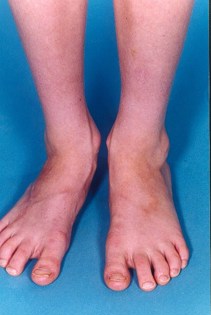Pigmented skin & wasting
A 10 year old boy has noticed a problem with his walking. His parents have noticed that his leg seems thinner. He is otherwise well and has no other problems. On examination he has pigmented skin changes over his trunk and wasting of his leg with a smaller right foot (photograph below)

- This is morphoea - a form of scleroderma. The skin changes can be mild and easily missed.
- The chronic inflammation, if not treated, can result in wasting and growth restriction. The impact of scleroderma varies depending upon site and size of lesion. Patients may be embarrassed or ashamed of their lesions especially if they are easily visible, or pigmented.
- Referral to camouflage make up services may be helpful if lesions are on the face or other conspicuous areas.
- Sometimes cosmetic surgery can be offered (including fat pads being used to replace lost subcutaneous fat layers) and needs specialist consultation to consider surgical risk.
- The affected skin can be more fragile and sometimes thickened and stiff. Emollients to moisturise the skin and gentle massage can improve the skin flexibility.
- The affected skin may burn more readily in sunlight so sun block is essential all year round.
- The affected skin may crack or split, can be difficult to heal and be prone to infection. Opportunist infections can be increased with immunosuppressive treatments.
- Growth can be affected – such as foot or hand size, limb length or chest wall deformity. Disfiguring lesions of the face can occur. The impact can be severe with distress and poor self-esteem.
- Families need support, practical advice (such as footwear) and may need psychology input.
- Treatment is with systemic immunosuppression (often systemic corticosteroids in combination with agents such as methotrexate and sometimes biologic therapy). There is need for more research including clinical trials to inform the 'optimal treatment' in this condition.

